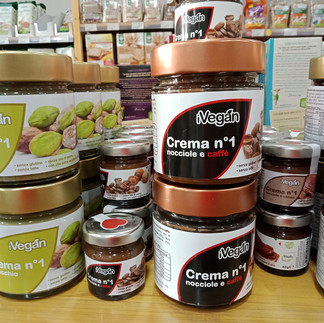What to eat and where to eat: tips on vegan Italian travel
- Nadia Fragnito

- Mar 11, 2024
- 6 min read
Updated: Sep 10, 2024
Planning a trip to Italy, but feeling a little anxious about what to eat and where? Want to know the best towns to visit, and how to explain to the waiter that you don't eat cheese?! Keep reading, because I'm sharing all my vegan Italy travel tips and more.

So, you might be wondering:
'What can I eat?'
'Where can I eat?'
'Where are the best vegan restaurants in Italy?'
Read on for my most seasoned advice on navigating Italy as a vegan, and most importantly, how to savour the most delicious plant-based experiences!
1. Research 'Happy Cow' before heading off to Italy.
Before I head to Italy, I first jump online to find the best vegan spots. Happy Cow (no commission here, just genuine appreciation!) offers a comprehensive guide to restaurants, cafes, grocery stores and more across Italy. You'll find photos and reviews from fellow travellers.
Start by making a list from the Happy Cow website or app. Then, cross-reference on social media platforms like Instagram to ensure the places are still operating. Imagine trekking across town in the summer heat only to find that amazing gelateria has become a phone shop! Google the location - is it convenient from where you're staying? Consider the travel time before committing.
I also sometimes like to 'street view' the neighbourhood for ambience, how to get there and safety considerations (especially helpful if you're travelling solo at night).

2. Find vegan food wherever you go, but your choices are easier in the city.
Cities like Rome, Milan, and Turin offer a plethora of options, from dedicated vegan restaurants to eateries with vegan-friendly menus. Cities are great for several reasons.
Firstly, they attract a diverse range of tourists and visitors, encouraging eateries to cater to various dietary needs and have knowledgeable staff.
Moreover, the progressive nature of city life, fuelled by a mix of university students and a diverse community, fosters an environment where traditions can co-exist with evolving ethical awareness.
Although veganism as a movement might not be as widespread here as in other countries, it is vegan friendly in many ways. Italy is home to some of the most passionate vegan change-makers and initiatives. For over two decades, the VEGANOK certification has labelled European products with an iconic leaf label. This makes the shopping experience for vegan travellers so much easier - the symbol doesn’t need any translation. You can find the VEGANOK emblem as well as other vegan logos popping up all over the place, even on wine bottles and in gelaterie.
3. Visit the regions with the most traditional vegan dishes.
Generally, southern regions tend to offer more plant-based options compared to the north, although there are exceptions. Larger northern cities still cater well to vegans, and regions like Liguria showcase a long-standing love affair with fresh vegetables, olive oil, and traditional vegan dishes such as farinata, focaccia, and trofie pasta.
Venturing off the tourist path may lead you to smaller towns (ones that don’t have a single Happy Cow entry or an English menu). In such cases, your chances of finding vegan-friendly options increase as you head further south, including central Italy regions, like Tuscany.
Why is the south more vegan-friendly?
Largely a Mediterranean diet with more vegetables, fruits, legumes, and cereals.
Environment: the territory supports more abundant vegetable and cereal production.
Many fresh pasta shapes consist of only flour and water.
Preference for olive oil over butter.
'Cucina povera' tradition: Historically, recipes contained less meat and more beans and cereals, contrasting with the animal-rich diets of alpine northern regions.
4. Memorise the vegan classics. Become an expert!
Even if a dish is vegan (especially in traditional trattorie and in smaller towns) it often won’t be labelled as such. The next best thing is memorising the regional dishes that happen to be vegan.
Here's a brief list to get you started:
Farinata/Cecina/Panelle
Ribollita
Pappa al pomodoro
Fagioli uccelletto
Fettunta
Bruschetta (check toppings)
Carciofi alla Romana
Carciofi alla Giudia
Spaghetti aglio e olio
Spaghetti pomodoro
Penne arrabbiata*
Pizza marinara*
Verdure grigliate
Cicorie
Caponata
Fave e cicorie
Taralli pugliese
Grissini
Fresh pasta* like orecchiette, strascinati, cicatelli, cavatelli, busiate, pici, trofie
Caldarroste
Marron glacé
Fruit granite
Fondente cioccolato*
And always fresh veggies, olives, marinated artichokes, sun-dried tomatoes, nuts, etc
*Important note: While these dishes ARE traditionally vegan, occasional adaptations may occur, so you may not want to rely on it as an infallible fact. My advice is to casually inspect your meal before tucking in or check with the waiter/staff.
Remember my friends, you are doing your very best, particularly when travelling off the beaten track in a non-English speaking country. Don’t beat yourself up if it doesn’t all go to plan.
Here are some examples:
At a restaurant in the Benevento hills, I ordered Penne Arrabbiata with full confidence. Yet, it arrived with guanciale (or something). Suffice to say, I re-ordered.
Pizza Marinara is typically a safe choice, with its simple tomato and herb topping. As long as the base is vegan (which is usually the case), it's a vegan's hangry-get-out-of-jail-free card. However, in the mountains of Anacapri, the pizzaiolo added anchovies.
For egg-free options, go for dried pasta like spaghetti or penne. Be wary of fresh pasta like tagliatelle, fettuccine or tortellini; they will probably contain eggs (unless it’s labelled ‘vegan’). Gnocchi can go either way—some are made without eggs (uova), but others include them for binding. Check with your waiter, especially in Rome where many recipes traditionally omit eggs.
In southern regions like Campania, lard was traditionally used alongside oil if it was available. While taralli are typically vegan, some, especially near Naples, contain lard (strutto). Watch for ‘strutto’ or 'lardo' in Italian ingredients lists. Some fried foods and rich breads could also contain lard, so it's best to be aware of this.
Fondente (dark chocolate) is usually dairy-free, but always check the ingredients. You'll find wonderful options, from my fave foil-wrapped gianduiotto fondente Torinese chocolates to rich dark chocolate gelato across Italy.
While I've been advocating the south as more pro-vegan, it's essential to recognise that southern cuisine still features animal ingredients. It's important to remember that the regions aren't intentionally 'vegan'; however, there are still plenty of food options for us to enjoy.
5. Learn Italian phrases and vocabulary when ordering food.
Download a translator app too. This way you can translate the ingredients on the spot. This will make the whole experience smoother and less awkward.
Save this list for your journey.
Basic vocab:
Soy milk: "Latte di soia"
Oat milk: "Latte d'avena"
Almond milk: "Latte di mandorla"
Do you have: "Avete...?"
Can I…?: “Posso”
Can we…?: “Possiamo…?”
Please: “Per favore”
Thank you: “Grazie”
Excuse me: “Scusi”
Very yummy: “Molto buono”
Helpful phrases:
I am vegan: "Sono vegano" (male) / "sono vegana" (female)
We are vegan: “Siamo vegani”
I don’t eat meat: "Non mangio carne"
We don’t eat meat: “Non mangiamo carne”
I don’t eat cheese: "Non mangio formaggio"
We don’t eat cheese: “Non mangiamo formaggio”
Without cheese: "Senza formaggio"
Without milk: "Senza latte"
Without eggs: "Senza uova"
What are the ingredients, please?: “Quali sono gli ingredienti, per favore?”
Without cheese please: "Senza formaggio, per favore"
Do you have soy milk?: "Avete il latte di soia?"
I would like…: “Vorrei…”
I will take…: “Prendo…”
We will take…: “Prendiamo…”
And if (and I mean when) you make a mistake- a smile can go a long way. You don’t need to utter a single syllable of Italian to get across your friendliness and enthusiasm. Non-verbal cues such as body language and facial expression also play a HUGE role in communication.
6. Discover my Top 10 list of vegan restaurants.
Here's my Top 10 Faves list of 100% vegan restaurants with links, focusing on city centres for your convenience (if you're based in the town centre). While there are now many fantastic vegan eateries across Italy, these are based on my personal visits. Consider this list just the beginning of your vegan culinary exploration.
L'orto gia salsamentario (Turin - PIEDMONT)
Mezzaluna (Turin - PIEDMONT)
La Colubrina (Milan - LOMBARDY)
Ops! (Rome - LAZIO)
Rifugio Romano (Rome - LAZIO)
Buddy Veggie Restaurant (Rome - LAZIO)
Haiku Palermo (Palermo - SICILY)
Pesto di pistacchio (Trani - PUGLIA)
Il Vegano (Florence - TUSCANY)
Origami (La Spezia - LIGURIA)
Honorable mentions:
La Cucina Dei Colori (Catania - SICILY) - Mostly vegan with some vegetarian options.
Origano (Rome - LAZIO) - Great vegan options, two locations in the heart of Rome
Flower Burger (ITALY) - 100% vegan franchise with the most beautiful burgers you have ever seen, along with delicious sides.
Sweet treats:
Grezzo (Rome - LAZIO) - Indulge in raw chocolate and sweet treats, including natural gelato in summer and cozy chocolate and cookies in winter.
Gelato Amico (Turin - PIEDMONT) - Enjoy creamy rice milk-based gelato with a variety of innovative flavours, gluten-free and refined sugar-free.
For groceries, cheese, and deli meats:
If you're in Rome, don't miss Vegan Store 83 in the Testaccio Market or iVegan near the Vatican for a wide selection of vegan products, including cheese, deli meats, snacks, pastries, and groceries.
With shops across Italy, NaturaSì is also a handy option for grocery shopping, with a solid range of vegan, organic and specialised products (not just food items).
I hope this gives you the confidence to explore Italy as a vegan and gets you excited about your epic culinary adventure!

























































Traveling to Italy as a vegan might seem daunting, but with the right preparation, it can be a delightful culinary journey! This guide offers excellent tips on navigating Italian cuisine, from discovering vegan-friendly dishes in southern regions to exploring plant-based eateries in cities like Rome and Milan. I love how it emphasizes traditional dishes that are naturally vegan.